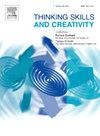反转交替使用任务
IF 4.5
2区 教育学
Q1 Social Sciences
引用次数: 0
摘要
发散性思维测试已被广泛用于识别创造潜力,并显示出有意义的预测能力。然而,这些措施经常被批评为采用不现实的任务,可能不会引发类似于现实世界创造性问题的创造性思维过程。本研究的目的是构建和验证一种新的发散思维测量方法——反向交替使用测试(rAUT),通过反转交替使用测试(AUT)的提示,并要求参与者生成用于日常用途的物体,而不是用于意外用途的物体,以使项目更具目标驱动性。样本由240名大学生组成,他们对测试结果做出了回应。我们的目的是研究新乐器的原创性和精加工成分是否可以通过自动人工智能评分系统(Ocsai)可靠地评分。rAUT的9个条目在独创性、流畅性和阐述性得分上表现出良好的内部一致性信度(α = 0.88, α = 0.89, α = 0.88)。独创性自动评分系统具有较高的评价信度(α =0.947)。为了检验rAUT相对于-à-vis的内部效度和潜在结构,我们采用了一个六因素验证性因素模型。模型拟合良好,CFI = 0.907, RMSEA = 0.05。与我们的预测一致,rAUT在统计上比AUT得到了更多的原创和更少的详细回答。与我们的预测一致,rAUT在统计上比AUT得到了更多的原创和更少的详细回答。值得注意的是,在rAUT上,任务完成时间与独创性得分的相关性也高于AUT。本文章由计算机程序翻译,如有差异,请以英文原文为准。
Reversing the alternate uses task
Divergent thinking tests have been widely used to identify creative potential and have demonstrated meaningful predictive power. However, these measures are often criticized for employing unrealistic tasks that might not elicit creative thinking processes similar to real-world creative problems. The goal of the present study was to construct and validate a new measure of divergent thinking, the Reverse Alternate Uses Test (rAUT), by reversing the prompts of the Alternate Uses Test (AUT) and asking participants to generate objects for mundane uses rather than surprising uses for objects in order to make the items more goal-driven. The sample consisted of 240 undergraduate students who responded to the rAUT. We aimed to examine whether the originality and elaboration components of the new instrument can be reliably scored by an automatic artificial intelligence scoring system (Ocsai). Nine items of rAUT have shown good internal consistency reliability for originality, fluency, and elaboration scores (α = 0.88, α = 0.89, α = 0.88, respectively). Automatic originality scoring system demonstrated high levels of inter-rater reliability with three human raters (α =0.947). To examine the internal validity and latent structure of the rAUT vis-à-vis the AUT, we applied a six-factor confirmatory factor model. The model indicated a good fit, with CFI = 0.907 and RMSEA = 0.05. In line with our predictions, rAUT elicited statistically more original and less elaborated responses than AUT. In line with our predictions, rAUT elicited statistically more original and less elaborated responses than AUT. Noteworthy, time-on-task also showed a statistically higher correlation with originality scores on rAUT, than AUT.
求助全文
通过发布文献求助,成功后即可免费获取论文全文。
去求助
来源期刊

Thinking Skills and Creativity
EDUCATION & EDUCATIONAL RESEARCH-
CiteScore
6.40
自引率
16.20%
发文量
172
审稿时长
76 days
期刊介绍:
Thinking Skills and Creativity is a new journal providing a peer-reviewed forum for communication and debate for the community of researchers interested in teaching for thinking and creativity. Papers may represent a variety of theoretical perspectives and methodological approaches and may relate to any age level in a diversity of settings: formal and informal, education and work-based.
 求助内容:
求助内容: 应助结果提醒方式:
应助结果提醒方式:


